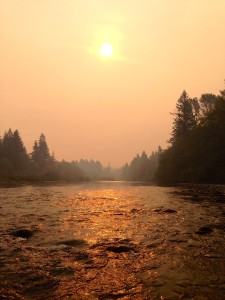Forest Fires and Drinking Water Quality

The Clackamas River as seen through the smoke of the 36 Pit Fire while sampling at McIver Park- 9/15/14.
With the 36 Pit Fire continuing to burn the the Clackamas River Watershed we’ve been getting a lot of questions about how forest fires along the river can affect drinking water quality. The forest fire will ultimately release a lot of carbon and nutrients into the river. So, what does this mean for your water?
Potential Impacts of the 36 Pit Fire on Water Quality
Short-term effects of the fire on the environment may consist of changes in pH and elevated nutrient and particulate concentrations in the burned area of the watershed during subsequent storm events. The post-fire storm events may also elevate metal concentrations in runoff water. The bulk of the initial sediment load, however, will likely be caught in upstream reservoirs and therefore limited downstream. Slight changes in pH have been observed over the past few days, but because this parameter is heavily linked to algal activity it can’t be specifically attributed to fire activity as of yet. pH is a measure of how acidic or basic water is on a scale of 0-14. If a pH becomes too high or too low it can disrupt aquatic life. We only expect slight changes from the forest fire, not enough to disrupt our river ecosystem.
Long-term effects may originate from the mobilized particulate fraction settling to the streams or reservoirs. The organic material (things that contain carbon) and metals that adsorb to the particulates will slowly dissolve, diffusing into the water. These dissolved particles can serve as a energy sources for microorganisms that have the ability to cause taste and odor problems in drinking water. Taste and odor, while unpleasant, is rarely a human health concern.
Human Health Concerns
So far no fire suppressants are being used on the fire, and as for the excess nutrients the Clackamas River Water Water Treatment Plant is capable of removing many of these compounds. Due to the expected increases in carbon we may see an increase in disinfection byproducts (DBPs) in finished drinking water as the chlorine disinfection process reacts with the organic matter. It’s important to note, however, that DBPs only pose a threat to human health if consumed at elevated levels for very long periods of time. If increases in DBPs are observed in finished water they will likely subside quickly after the first fall storm events.





